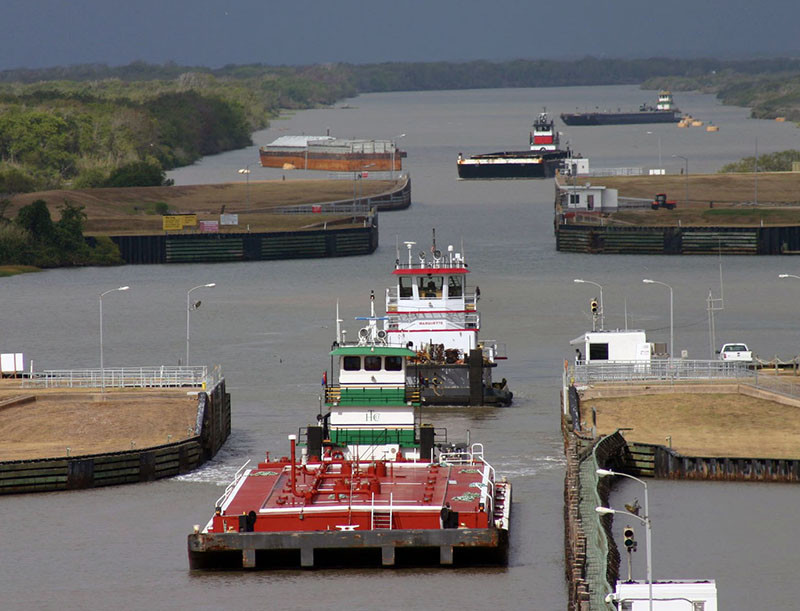President Biden unveiled an ambitious plan to improve the U.S.’s aging infrastructure on Wednesday that proposes funds for inland waterways, coastal ports, land ports of entry and ferries.
Biden chose to lay out his vision for an infrastructure overhaul at a carpenters training center outside Pittsburgh, where he began his campaign, and where three major rivers converge at one of the busiest spots for navigation along the inland river system.
“It is not a plan that tinkers around the edges,” the president said. “It is one-in-a-generation investment in America.”
Among many other elements of the proposal, Biden calls on Congress to invest an additional $17 billion in inland waterways, coastal ports, land ports of entry and ferries, which, he says, “are vital to our nation’s freight.” No more details were immediately available about how that money would be spent, or what the president’s priorities would be in this sector.
But it’s clear that his initiatives will put climate change and clean energy as priorities. He includes in his waterways initiative a “Healthy Ports program to mitigate the cumulative impacts of air pollution on neighborhoods near ports, often communities of color.”
The plan says that these investments “will position the United States as a global leader in clean freight and aviation.”
Waterways and ports advocates had been urging the Biden administration not to forget the waterways as it crafted its infrastructure package, stressing the importance of river navigation and ports to the national economy and to maintaining U.S. competitiveness in global trade.
Although federal funding for waterways improvements has increased over the past few years, and several projects are finally under construction or completed, the industry says there’s still much more to be done. They cite the current $7 billion backlog of authorized inland lock and dam projects as well as needed improvements at coastal ports to welcome larger ships and allow for development of offshore renewable energy.
Called the American Jobs Plan, the initiative is the first of a two-part package that will also include a forthcoming domestic component, the American Family Plan, that aims to revitalize the economy, help workers and fight climate change.
Biden plans to pay for the programs by raising the corporate tax rate and forcing multinational corporations to pay more taxes on profits they earn overseas.
Republicans and business groups oppose these tax increases, and this opposition will likely mean trouble for Biden during negotiations with Congress.
House Speaker Nancy Pelosi says she wants to pass the bill in the House by July 4. Sen. Tom Carper, chair of the Senate Environment and Public Works Committee, says he wants to pass the highway portion of the bill by Memorial Day.
Soybean growers, who depend on an efficient waterways system to get their products to both domestic and overseas markets, praised the proposal. “The Biden administration clearly aspires to promote a transportation system that provides connectivity in an environmentally sustainable manner,” Mike Steenhoek, executive director of the Soybean Transportation Coalition, said in a statement. “Investing in barge transportation utilizing the inland waterways is arguably one of the more effective ways of achieving this goal.”
The Trump administration had also promised a major infrastructure modernization bill, but it never gained traction in Congress. Although agreeing with the need, lawmakers couldn’t agree on how to fund it.
But there is some reason for hope this time. “While many of us have been jaded over the last several years by the promise of a potential infrastructure package moving forward, this time feels different,” Tracy Zea, president and CEO of the Waterways Council Inc. (WCI), an advocacy group for spending on inland river navigation, said in its recent newsletter.
He said Congress has already done much work on an infrastructure package over the past several years and has approved strong funding for lock and dam modernization. “While last year’s effort does not guarantee that lock modernization will be included in a potential infrastructure package, the fact that inland waterways were included may be a harbinger for locks to be included in the next effort," Zea said. "As we continue to work with elected leaders, our hope is that infrastructure can be a bipartisan issue, with legislation addressing the current needs of the system, and not just another weekly talking point.”
Zea pointed out that despite improved federal investments in waterways and recent policy changes that will help improve the overall lock and dam infrastructure, “the fact remains that most locks on the system are well past their 50-year design life, and are in need of modernization to more efficiently manage the size of today’s tows laden with America’s building block commodities.” He noted that the American Society of Civil Engineers recently gave the inland waterways a D+ grade in its 2021 infrastructure report card, a slight improvement over 2020.
Specifically, the inland navigation industry urged Congress at a recent hearing to include three elements in an infrastructure package: increased federal funding for lock and dam projects and ports, fast-track construction of the new Coast Guard waterways commerce cutters (buoy tenders), and improvements to the Army Corps of Engineers’ contracting process for commercial dredging along inland rivers.
“An infrastructure package with a robust maritime component will both increase shipper confidence in waterborne commerce over the period of recovery from the pandemic, and, over the long term, help secure a transformed waterways system that supports robust domestic and international trade,” Del Wilkins, president of Illinois Marine Towing, told a February hearing before the House subcommittee on Coast Guard and Maritime Transportation. “Failure to make these investments will ultimately force cargo to move by less efficient and less environmentally sustainable modes,” he said.




